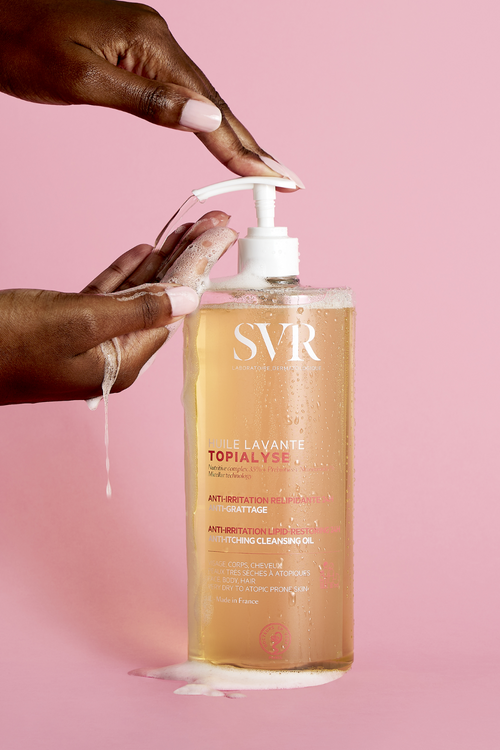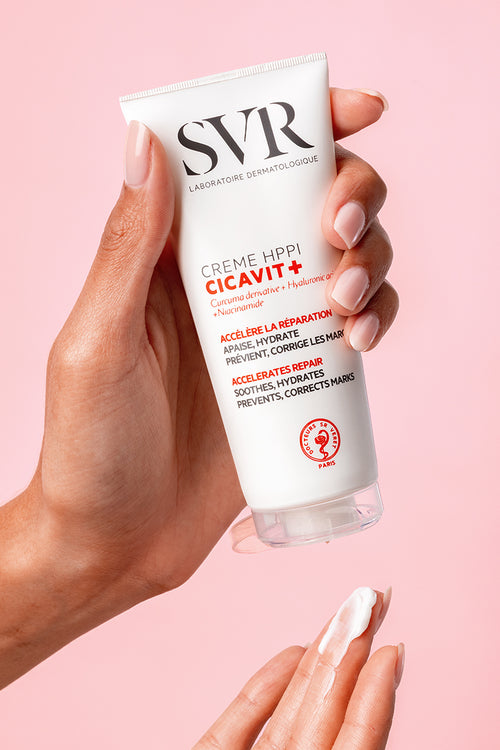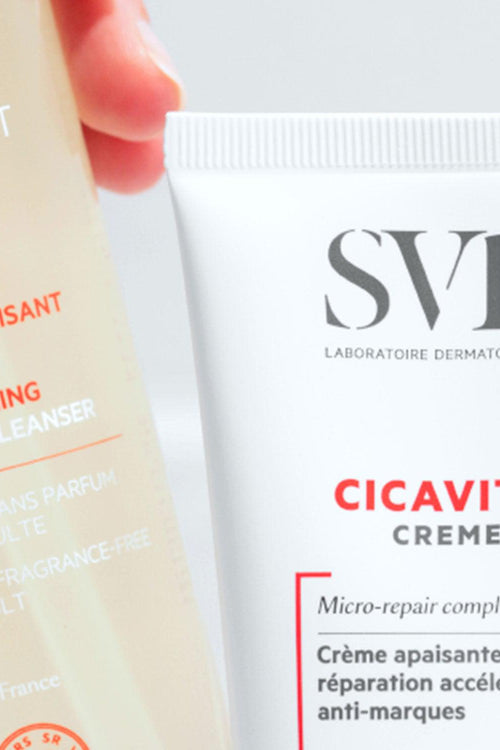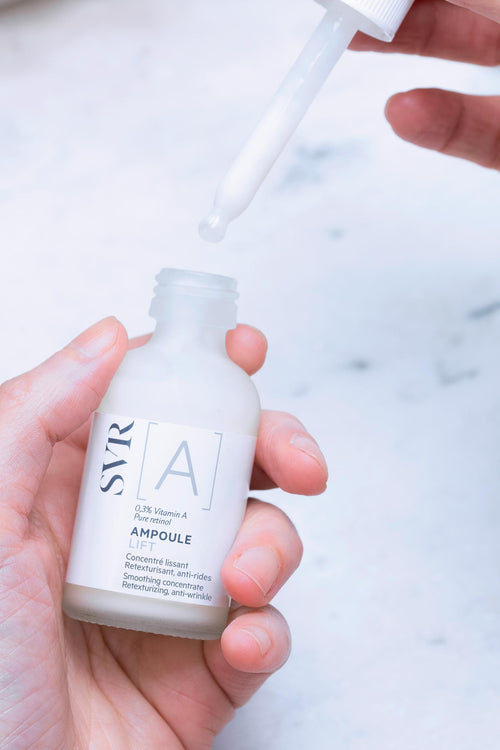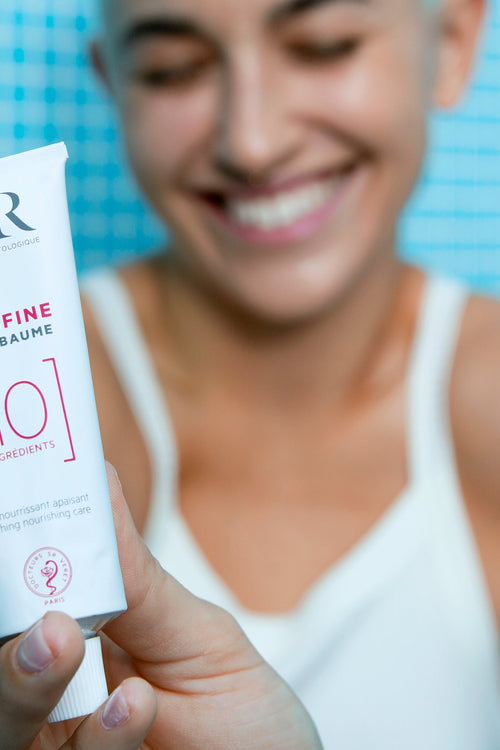Atopy, learning to live with it
We've all seen those toddlers with their cheeks on fire, those children desperately scratching the folds of their arms. According to the French Society of Dermatology, 20% of children under 7 years old and 15% of infants aged 3 months and over (1) suffer from Atopic Dermatitis, which affects the whole family. It often continues into adulthood and affects around 4% (2) of the French population. The problem: in 30 years, the number of cases has tripled (3) !
What is atopic dermatitis?
According to its “official definition” (4) , atopic dermatitis – also called atopic eczema – is a chronic inflammatory skin disease due to an abnormality of the immune response and a deficiency of the skin barrier.
Its symptoms: dry skin, redness and inflammatory lesions. This inflammation leads to itching which causes scratching lesions and sometimes secondary infections. It progresses in outbreaks, and is more or less severe (the scale used in France is the SCORAD, or Scoring atopic dermatitis)
For what ? Healthy skin constitutes a defense barrier against external agents. But skin affected by atopic dermatitis is like a breached wall, which allows attackers (pathogens) to pass through and its defenders (hydration) to escape.
What causes it? There is both a genetic factor (between 50 and 70% of affected individuals have a parent who is also affected. If both parents are affected, the risk reaches 80% (5) ), an immune factor (increased sensitization to certain pathogens) and an environmental factor (including pollution).
Doctor, explain atopy to us:
A strong impact on quality of life:
Atopic dermatitis can be hard to live with.
In little ones, the itching, which persists at night, can ruin their sleep and their life, and in turn that of an entire family. Not to mention the dismay and guilt of parents who see their child suffering without being able to calm them down.
In children and adolescents, visible signs can lead to teasing and psychological problems.
And in adults, studies have shown that they develop sleep disorders which lead to persistent fatigue (6) , hence difficulties in professional life (concentration, efficiency), a drop in self-esteem (especially in women with eczema on the eyelids), and even anxiety or even depression. A real vicious circle!
What other solutions than medication:
• Emollient creams, O-bli-ga-toires!
“The best treatment for atopic skin remains the daily application of an emollient,” says Professor Tennstedt. Indeed, it has been clearly shown in studies (7) that their long-term use not only has a beneficial effect on skin dryness, but also makes it possible to space out flare-ups and therefore to have less frequent use of treatments. topical corticosteroids. They must contain a high concentration of nourishing active ingredients (vegetable oils and butters), soothing active ingredients (niacinamide, madecassoside, bisabolol, etc.), even anti-bacterial ingredients to prevent the proliferation of Staphylococcus Aureus.
The problem: children must be educated from a very young age to not only agree to let themselves be smeared with cream every day without complaining, but also later to do it on their own regularly! This is quite an education that dermatologists must undertake. There are also Therapeutic Education programs within hospital departments to learn how to take good care of oneself.
• Thermal treatments
Prescribed by a doctor and reimbursed by Health Insurance, 3-week thermal treatments have shown their effectiveness on pathologies such as atopy. In addition to general hydrothermal treatments (baths, showers, massages) and daily local treatments, it is a place for therapeutic education and exchange. It allows the patient to relieve their symptoms and gain more autonomy in the management of their pathology. Around ten French spas are suitable for dermatology
• Phototherapy
In adolescents and adults for whom usual treatments remain a failure, UVB phototherapy, or combining UVA and UVB can lead to improvement. But beware ! 20 and 25 sessions at a rate of 3 (sometimes 2) sessions per week are necessary! And these are medical treatments carried out only at and under the control of the dermatologist.
Good gestures:
• Gentle cleansing: with cleansing oils or soap-free dermatological bars
• No hot and long baths, which increase the permeability of the skin. We prefer a 5 minute lukewarm shower
• When you get out of the shower or after washing your hands, dab the skin with the towel, do not rub it. She is already weakened enough!
• To teach the little ones: during flare-ups, do not scratch with your nails, which are too aggressive and potentially carry germs, but with the palm or the back of the hand
• Purified cosmetic formulas: no perfumed cosmetic products, with potentially irritating or allergenic preservatives.
• We avoid all domestic and furniture products containing volatile organic compounds (VOC): construction, decoration, insulation materials, paints, thinners, glues and varnishes, but also cleaning agents, deodorizers, stain removers, insecticides and descaling agents. Not always easy
• For clothing, we favor loose cuts to limit friction on the skin, and cotton, linen or silk rather than wool
The skin microbiota, the way forward?
It has long been known that Staphylococcus aureus – Staphylococcus Aureus – plays a determining role in atopic eczema. But the best knowledge of what was formerly called the skin flora has shown that the diversity and balance between the microorganisms which make up the microbiota prevent colonization by aggressive species and participate in the defenses of the skin's immune system. Since 2012 it has been recognized (8) that eczema is associated with a strong imbalance of this microbiota where Staphylococcus Aureus becomes predominant. It attaches to the skin and creates a shield that helps amplify eczema flare-ups, dryness and itching. If corticosteroids remain the standard treatment, we are discovering the benefit of creating emollients enriched with active ingredients (pre and postbiotics) which make it possible to rebalance the microbiota, reduce the inflammatory factor and prevent Staphylococcus aureus from taking hold.
(1) ISAAC (International Study of Asthma and Allergies in Childhood) (2) Epi-Aware Study (Epidemiology of Adults Patients With Atopic Dermatitis). Sanofi Genzyme & Regeneron 2016, PGA (Patient Global Assessment) (3) Atopic dermatitis: epidemiology in France, definitions, natural history, association with other atopic manifestations, severity scores, quality of life. E. Mahé. Ann. Dermatol. Venereol. 2005; 132 (4) http://allergo.lyon.inserm.fr/2019_DESC/8.Eczema.pdf (5) https://www.inserm.fr/information-en-sante/dossiers-information/dermatite-atopic- eczema-atopic (6) Patient burden of moderate to severe atopic dermatitis (AD), Simpson EL et al. J Am Acad Dermatol 2016 Mar;74(3):491–498. (7) Wollenberg A, Barbarot S, Bieber T et al. Consensus-based European guidelines for treatment of atopic eczema (atopic derma-titis) in adults and children: part I. J Eur Acad Dermatol Venereol. 2018 May;32(5):657-682. doi: 10.1111/jdv.14891. (8) Temporal shifts in the skin microbiome associated with disease flares and treatment in children with atopic dermatitis, Kong & al, Genome Research, 2012





